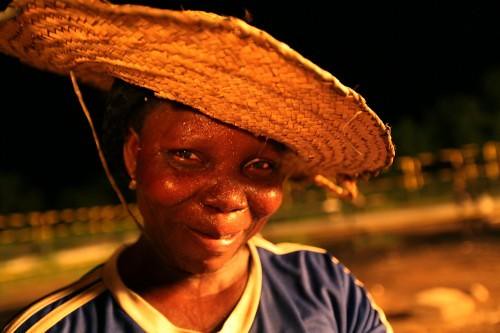Today, 1 October 2010, marks the 50th anniversary of Nigeria’s independence. Apart from government officials and a few deluded individuals, most people agree there is little to celebrate.
But that’s not quite true.
Yes, politically and economically the country is a mess and its human rights record is appalling.
However, we can, as I did last week, celebrate women and our artists. I listed a small selection of my personal favourites and I make no apologies for leaving anyone out.
Literature
My favourite and probably one of the least well known is the Nigerian writer Amos Tutuola, author of ‘The Palm-wine Drunkard’ (1946) and ‘My Life in the Bush of Ghosts’ (1954). Tutuola wrote in ‘broken English’ which added character and colour to his texts.
I’ve lost count of the number of times I’ve read these two books. My brother and I used to take turns reading the stories aloud to my children, who would sit in silence, mesmerized by the language and magical adventures of Tutuola’s characters.
The first time I took them to my home town, driving along the roads of the Niger Delta, we passed through the endless ‘Bush of Ghosts’, wondering about the possibilities of the happenings in the deep forests.
Ben Okri is another writer who conjured up magical spirits from a parallel universe of gods and those who never die. His novel ‘The Famished Road’ won the Booker Prize in 1991. Unfortunately, Okri has never been able to come near to writing another masterpiece.
Of course there are the familiar writers like Chinua Achebe, who is famous for his social and political commentary, and Buchi Emecheta, whose writings on women and the intersection of race, gender and sexuality in Britain were groundbreaking at the time.
Of contemporary writers, two I consider exceptional are Chris Abani, author of ‘Graceland’, and Chimamanda Ngozi Adichi, author of ‘Half of a Yellow Sun’, an epic novel centered on the Biafra war. In their writings, both Abani and Adichi address issues such as poverty, social justice, feminism and homophobia.
Art as activism, as a tool for transformation
I like the way more and more artists and writers are using their work to explore and expose injustice as well as traditional and popular culture.
Sculptor Sokari Douglas-Camp documented Kalabari art and culture in her early work. In 2006 she won the prize for the Ken Saro-Wiwa living memorial with her amazing full-sized Nigerian bus, sculptured out of steel.

Sokari Douglas-Camp's Bus
One has to imagine Saro Wiwa riding the bus, which is full of barrels of oil, and spreading his message to the people, the Nigerian government and the oil companies.
The message is: ‘I accuse the oil companies of practising genocide against the Ogoni people.’
Photographer Lucy Azubuike uses the camera to tell stories of the female body and sexuality. On her work on trees she writes:
‘Trees often play the central role in my work. I connect tree images and forms with my own experiences in life, and those of other people, to pose the questions that interest me. The marks made par hazard with external factors like the effects of wind, rain, sun and animals are particularly of interest to me. Tree formations, deformations and even reformations tell interesting stories. These stories I use to ask questions at will.’

Lucy Azubuike's Trees
And finally, I admire the exceptional work of another Nigerian visual activist, George Osodi, who used his camera to document the environmental and military violence in the Niger Delta as well as social commentary on the ‘uncelebrated’ underbelly of the country.

George Osodi's photograph

